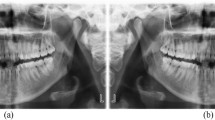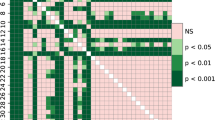Abstract
Objectives
This study aimed to examine the performance of deep learning object detection technology for detecting and identifying maxillary cyst-like lesions on panoramic radiography.
Methods
Altogether, 412 patients with maxillary cyst-like lesions (including several benign tumors) were enrolled. All panoramic radiographs were arbitrarily assigned to the training, testing 1, and testing 2 datasets of the study. The deep learning process of the training images and labels was performed for 1000 epochs using the DetectNet neural network. The testing 1 and testing 2 images were applied to the created learning model, and the detection performance was evaluated. For lesions that could be detected, the classification performance (sensitivity) for identifying radicular cysts or other lesions were examined.
Results
The recall, precision, and F-1 score for detecting maxillary cysts were 74.6%/77.1%, 89.8%/90.0%, and 81.5%/83.1% for the testing 1/testing 2 datasets, respectively. The recall was higher in the anterior regions and for radicular cysts. The sensitivity was higher for identifying radicular cysts than for other lesions.
Conclusions
Using deep learning object detection technology, maxillary cyst-like lesions could be detected in approximately 75–77%.





Similar content being viewed by others
References
Sahiner B, Pezeshk A, Hadjiiski LM, Wang X, Drukker K, Cha KH, Summers RM, Giger ML. Deep learning in medical imaging and radiation therapy. Med Phys. 2019;46:e1–e36.
Cao Z, Yang G, Chen Q, Chen X, Lv F. Breast tumor classification through learning from noisy labeled ultrasound images. Med Phys. 2020;47:1048–57.
Wang X, Liang X, Jiang Z, Nguchu BA, Zhou Y, Wang Y, Wang H, Li Y, Zhu Y, Wu F, Gao JH, Qiu B. Decoding and map** task states of the human brain via deep learning. Hum Brain Mapp. 2020;41:1505–19.
Cao Z, Duan L, Yang G, Yue T, Chen Q. An experimental study on breast lesiondetection and classification from ultrasound images using deep learning architectures. BMC Med Imaging. 2019;19:51.
Chen S, Zhong X, Hu S, Dorn S, Kachelrieß M, Lell M, Maier A. Automatic multi-organ segmentation in dual energy CT (DECT) with dedicated 3D fully convolutional DECT networks. Med Phys. 2020;47:552–62.
Ariji Y, Fukuda M, Kise Y, Nozawa M, Yanashita Y, Fujita H, et al. Contrast-enhanced computed tomography image assessment of cervical lymph node metastasis in patients with oral cancer by using deep learning system of artificial intelligence. Oral Sur Oral Med Oral Pathol Oral Radiol. 2019;127:458–63.
Kise Y, Ikeda H, Fujii T, Fukuda M, Ariji Y, Fujita H, et al. Preliminary study on the application of deep learning system to diagnosis of Sjogren’s syndrome. Dentomaxillofac Radiol. 2019;48:20190019.
Ariji Y, Sugita Y, Nagao T, Nakayama A, Fukuda M, Kise Y, et al. CT evaluation of extranodal extension of cervical lymph node metastases in patients with oral squamous cell carcinoma using deep learning classification. Oral Radiol. 2020;36:148–55.
Ariji Y, Yanashita Y, Kutsuna S, Muramatsu C, Fukuda M, Kise Y, Nozawa M, Kuwada C, Fujita H, Katsumata A, Ariji E. Automatic detection and classification of radiolucent lesions in the mandible on panoramic radiographs using a deep learning object detection technique. Oral Surg Oral Med Oral Pathol Oral Radiol. 2019;128:424–30.
Fukuda M, Inamoto K, Shibata N, Ariji Y, Yanashita Y, Kutsuna S, Nakata K, Katsumata A, Fujita H, Ariji E. Evaluation of an artificial intelligence system for detecting vertical root fracture on panoramic radiography. Oral Radiol. 2020;36:337–343. https://doi.org/10.1007/s11282-019-00409-x.
Murata M, Ariji Y, Ohashi Y, Kawai T, Fukuda M, Funakoshi T, Kise Y, Nozawa M, Katsumata A, Fujita H, Ariji E. Deep-learning classification using convolutional neural network for evaluation of maxillary sinusitis on panoramic radiography. Oral Radiol. 2019;35:301–7.
Hiraiwa T, Ariji Y, Fukuda M, Kise Y, Nakata K, Katsumata A, Fujita H, Ariji E. A deep-learning artificial intelligence system for assessment of root morphology of the mandibular first molar on panoramic radiography. Dentomaxillofac Radiol. 2019;48:20180218.
Ohashi Y, Ariji Y, Katsumata A, Fujita H, Nakayama M, Fukuda M, Nozawa M, Ariji E. Utilization of computer-aided detection system in diagnosing unilateral maxillary sinusitis on panoramic radiographs. Dentomaxillofac Radiol. 2016;45:20150419.
Szegedy C, Liu W, Jia Y, Sermanet P, Reed S, Anguelov D, Erhan D, Vanhoucke V, Rabinovich A. Going Deeper with Convolutions. In Proc. IEEE Conference on Computer Vision and Pattern Recognition (CVPR), 2015; 1–9. https://arxiv.org/abs/1409.4842. Accessed 20 Dec 2015.
Lee JH, Han SS, Kim YH, Lee C, Kim I. Application of a fully deep convolutional neural network to the automation of tooth segmentation on panoramic radiographs. Oral Surg Oral Med Oral Pathol Oral Radiol. 2020;129:635–42.
Ghazi P, Hernandez AM, Abbey C, Yang K, Boone JM. Shading artifact correction in breast CT using an interleaved deep learning segmentation and maximum-likelihood polynomial fitting approach. Med Phys. 2019;46:3414–30.
Chen H, Zhang K, Lyu P, Li H, Zhang L, Wu J, Lee CH. A deep learning approach to automatic teeth detection and numbering based on object detection in dental periapical films. Sci Rep. 2019;9:3840.
Tuzoff DV, Tuzova LN, Bornstein MM, Krasnov AS, Kharchenko MA, Nikolenko SI, Sveshnikov MM, Bednenko GB. Tooth detection and numbering in panoramic radiographs using convolutional neural networks. Dentomaxillofac Radiol. 2019;48:20180051.
Kats L, Vered M, Zlotogorski-Hurvitz A, Harpaz I. Atherosclerotic carotid plaque on panoramic radiographs: neural network detection. Int J Comput Dent. 2019;22:163–9.
Yu J, Sharpe SM, Schumann AW, Boyd NS. Detection of broadleaf weeds growing in turfgrass with convolutional neural networks. Pest Manag Sci. 2019;75:2211–8.
Acknowledgements
We thank Nancy Schatken, BS, MT(ASCP), from Edanz Group (https://en-author-services.edanzgroup.com/) for editing a draft of this manuscript.
Author information
Authors and Affiliations
Corresponding author
Ethics declarations
Conflict of interest
Hirofumi Watanabe, Yoshiko Ariji, Motoki Fukuda, Chiaki Kuwada, Yoshitaka Kise, Michihito Nozawa, Yoshihiko Sugita, and Eiichiro Ariji declare that they have no conflicts of interest.
Human rights statements and informed consent
All procedures were performed in accordance with the ethical standards of the responsible committee on human experimentation (institutional and national) and with the Helsinki Declaration of 1964 and later versions.
Animal rights statement
This article does not contain any studies with animal subjects performed by any of the authors.
Additional information
Publisher's Note
Springer Nature remains neutral with regard to jurisdictional claims in published maps and institutional affiliations.
Rights and permissions
About this article
Cite this article
Watanabe, H., Ariji, Y., Fukuda, M. et al. Deep learning object detection of maxillary cyst-like lesions on panoramic radiographs: preliminary study. Oral Radiol 37, 487–493 (2021). https://doi.org/10.1007/s11282-020-00485-4
Received:
Accepted:
Published:
Issue Date:
DOI: https://doi.org/10.1007/s11282-020-00485-4




